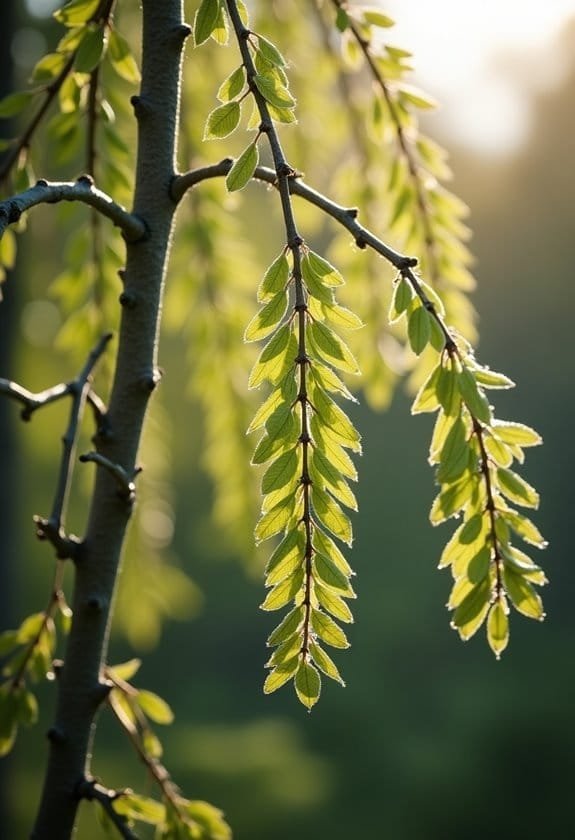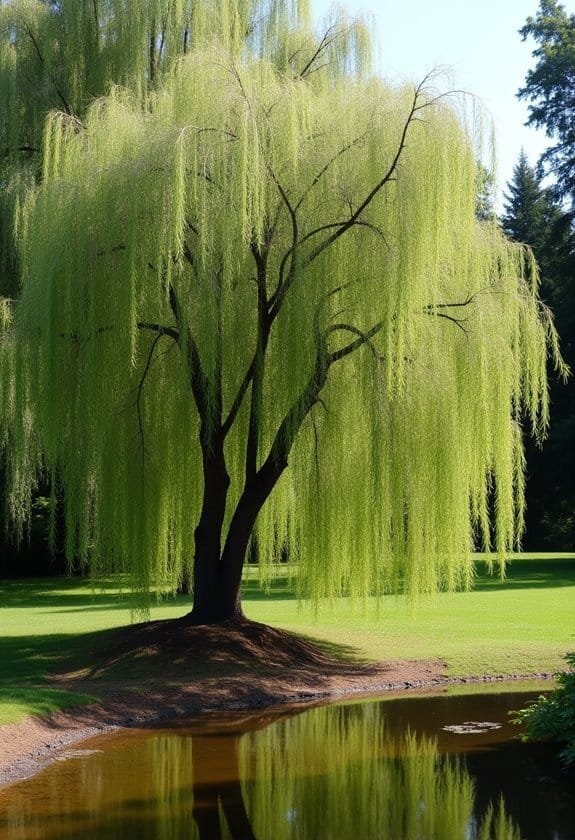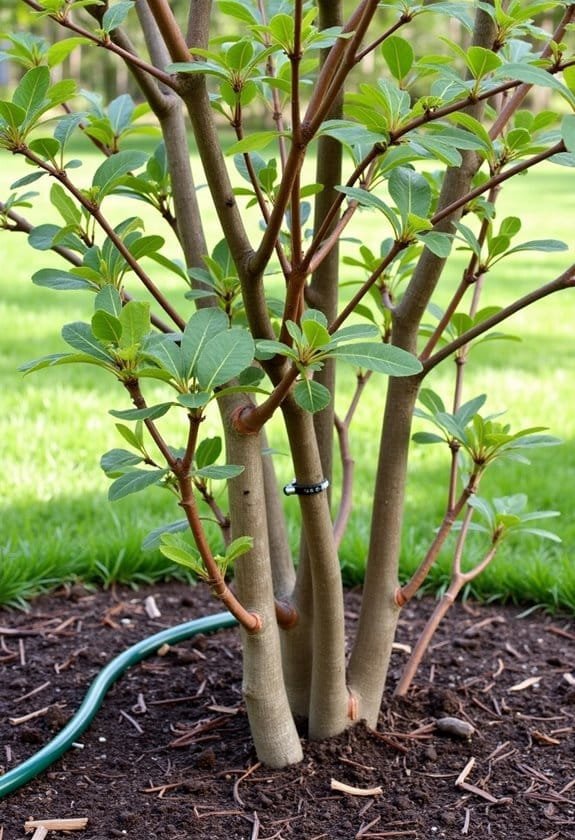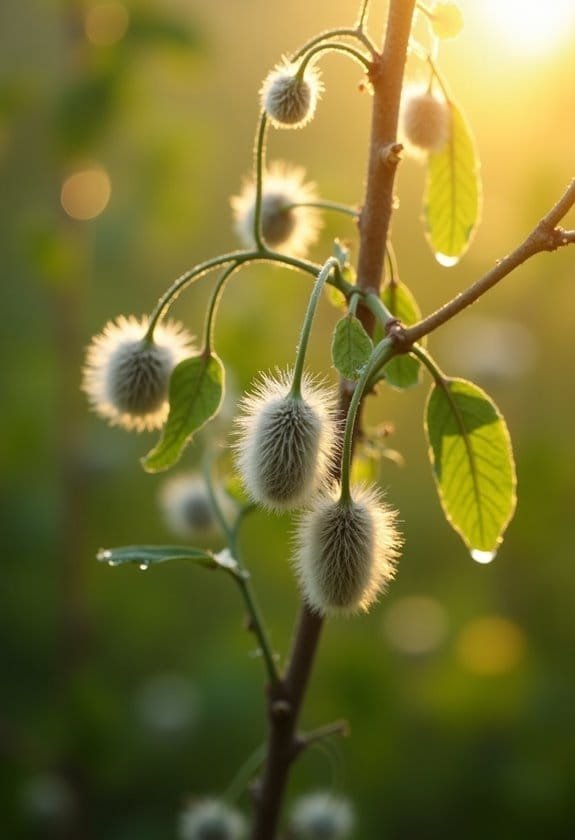Salix aegyptiaca, known as Musk Willow or Egyptian willow, is a remarkable deciduous shrub or small tree that reaches heights of 2.5 to 10 meters. With its striking red, hairy twigs, this species flourishes in temperate areas, particularly along riverbanks and floodplains. It's crucial for local ecosystems, providing an essential food source for early-season pollinators like bees with its cylindrical catkins that can extend up to 20 centimeters. To thrive, Musk Willow requires full sunlight, well-draining soil, and regular watering, making it a valuable addition, not only for biodiversity but also for ornamental gardens. There's much more to uncover regarding its unique attributes.
Main Points
- Salix aegyptiaca, commonly known as Musk Willow, is a deciduous shrub that thrives in temperate regions near water sources.
- This plant features distinct red, hairy twigs and cylindrical catkins that bloom before leaf development, attracting early pollinators.
- It requires full sunlight and well-draining, slightly acidic soil for optimal growth, with regular watering during establishment.
- Known for its anti-inflammatory and analgesic properties, Musk Willow has historical ties to the development of aspirin.
- It faces threats from pests like spider mites and aphids, and overwatering can lead to root rot, requiring careful maintenance.
Introduction

Salix aegyptiaca, commonly known as Musk Willow, stands as a remarkable member of the willow family that has garnered attention for both its ornamental and practical uses.
The species presents itself as a deciduous shrub or small tree, reaching heights between 2.5 to 10 meters, with distinctive red, hairy twigs during its early growth stages.
This adaptable plant has established its presence across temperate regions of northern Iran, Iraq, southeastern Turkey, and Azerbaijan, where it thrives along floodplains and riverbanks in moist, sandy-gravelly soils.
Common Name
Among its common names, the Egyptian willow or Musk willow stands as the primary identifier for Salix aegyptiaca. These appellations reflect both its perceived geographical connection and its distinctive aromatic characteristics, though intriguingly, the species isn't native to Egypt despite its common name suggesting otherwise.
The designation "Musk willow" derives from the plant's remarkably fragrant flowers, which have become integral to various cultural culinary traditions. These aromatic blooms are particularly valued in Egyptian and Persian cuisines, where they're skillfully transformed into fragrant syrups and distillates for both beverages and pastries.
The common names also serve to distinguish this species from other willows through its unique features, including its characteristically striped wood and densely hairy twigs during early growth phases.
While the Egyptian willow moniker may mislead regarding its origins, it has become firmly established in horticultural circles, reflecting the plant's widespread cultivation and ornamental significance in Egyptian gardens and landscapes, where its kidney-shaped leaves and cylindrical catkins create striking visual displays.
Scientific Name
The binomial nomenclature Salix aegyptiaca was formally established by Carl Linnaeus in 1759, placing this distinctive willow species within the expansive Salicaceae family. This scientific classification positions the Musk Willow among more than 300 recognized species within the diverse Salix genus, highlighting its significance in botanical taxonomy.
The specific epithet "aegyptiaca" presents an intriguing nomenclatural curiosity, as it suggests an Egyptian connection despite the species not being native to Egypt's geographical boundaries.
Within botanical circles, the plant has also been known by its synonym Salix medemii Boiss, which represents an alternative classification that acknowledges the complex evolutionary relationships within the Salix genus.
The scientific naming of this species reflects its position within the broader willow family, while simultaneously distinguishing it from its numerous relatives.
This taxonomic precision proves particularly valuable when studying the plant's ecological preferences, especially its notable adaptation to floodplain environments and moisture-rich habitats, where it demonstrates remarkable resilience and environmental plasticity.
Overview
Widely recognized for its distinctive red, hairy twigs and impressive catkins, Musk Willow stands as a remarkable member of the Salicaceae family. This deciduous shrub or small tree, which reaches heights between 2.5 to 10 meters, commands attention in its native temperate regions across northern Iran, Iraq, southeastern Turkey, and Azerbaijan.
Musk Willow's most striking features include its thick, crimson twigs, which maintain their characteristic hairiness through their first two years of growth. The plant's foliage presents an elegant display of kidney-shaped to half-heart-shaped leaves, spanning 5 to 15 centimeters in length, while its cylindrical to ovate catkins can extend impressively up to 20 centimeters.
Naturally adapted to flourish in floodplains and moist, sandy-gravelly soils, this species serves both ornamental and ecological purposes. While its commercial applications remain limited, the plant's attractive flowers yield aromatic infusions comparable to rose water.
Beyond its aesthetic appeal, Musk Willow plays a crucial role in supporting local ecosystems, providing essential sustenance for pollinators and contributing to biodiversity in its native habitats.
Key Features
Salix aegyptiaca stands as an impressive specimen, reaching heights between 2.5 to 10 meters with distinctive red, hairy twigs that mature into smooth branches over time.
The tree's notable features include kidney-shaped or half-heart-shaped leaves measuring 5 to 15 cm in length, creating a striking visual display throughout its growing season.
Its cylindrical catkins, extending up to 8 inches long, emerge before the leaves in spring, serving as essential attractants for pollinators while adding to the tree's ornamental value.
Growth Size
As one of the medium-sized willows, Salix aegyptiaca features a robust growth pattern, reaching heights between 5 to 10 meters with a spread of up to 6 meters. This versatile tree's growth size makes it an excellent choice for both urban and rural landscapes, where it can serve as an impressive focal point or natural screen.
The tree's rapid growth rate contributes considerably to its final dimensions, allowing it to establish itself quickly in suitable environments. When provided with ideal conditions, including full sunlight and well-draining soil, the musk willow develops a substantial presence in the landscape.
Its mature size is complemented by an extensive root system that anchors the tree firmly while seeking out available moisture and nutrients.
The growth size of Salix aegyptiaca proves particularly advantageous in situations requiring swift vertical development and horizontal coverage. While not as towering as some of its willow relatives, its moderate stature makes it more manageable in designed landscapes, where its ultimate dimensions won't overwhelm surrounding plantings or structures.
Appearance
Known for its striking ornamental features, the Musk Willow displays a distinctive combination of thick, reddish twigs and kidney-shaped leaves that create an impressive visual profile. The twigs begin their growth cycle with a hairy texture and vibrant red coloration, gradually transforming to a smooth, glabrous surface as they mature.
The foliage presents an enchanting display of half-heart-shaped leaves, spanning 5 to 15 centimeters in length and 3 to 6 centimeters in width, which forms a dense, verdant canopy throughout the growing season.
Adding to its visual appeal, the tree produces remarkable egg-shaped flower buds measuring 6 to 9 millimeters in length and 4 to 6 millimeters in diameter. These buds develop into spectacular cylindrical to ovate catkins that can extend up to 20 centimeters, emerging before the leaves in spring like delicate hanging ornaments.
The flowers, particularly prized for their decorative quality, serve both aesthetic and practical purposes, as they can be transformed into aromatic syrups or distilled essences, making the Musk Willow a multifaceted addition to ornamental gardens.
Flowering Season
The vibrant awakening of spring heralds the Musk Willow's flowering season, with its distinctive catkins emerging before the leaves unfurl. Male catkins appear first, stretching up to an impressive 20 centimeters in length and producing sweet, sugary sap that beckons early-season pollinators to feast.
The dioecious nature of Salix aegyptiaca means that male and female flowers develop on separate plants, creating an intricate reproductive strategy that guarantees genetic diversity. Female catkins make their entrance shortly after their male counterparts, eventually transforming into downy seed heads that release their cargo on spring breezes.
This carefully orchestrated flowering sequence plays an essential role in supporting local ecosystems, particularly for emerging insects seeking sustenance after winter dormancy.
The timing of the bloom, occurring before leaf development, proves advantageous for both the tree and its pollinators, as the unobstructed flowers provide easy access to nutritious nectar and pollen. This mutually beneficial relationship demonstrates the Musk Willow's ecological significance as an early-season resource for numerous pollinating species.
Growing Requirements

Salix aegyptiaca flourishes in full sunlight and demands consistently moist, well-draining soil conditions to support its extensive root system.
The species demonstrates remarkable adaptability to temperature fluctuations, withstanding winter temperatures as low as -20°C while maintaining its vigorous growth pattern throughout the warmer months.
For ideal development, the Musk Willow requires regular watering during establishment, particularly in spring and early autumn when new growth emerges and root systems expand into surrounding soil.
Light
Among the essential growing requirements, direct sunlight plays a significant role in the successful cultivation of Musk Willow.
This remarkable species demands ideal light conditions, specifically positioning within one foot of a south-facing window to guarantee robust development and sustained liveliness.
The light requirements of Salix aegyptiaca are non-negotiable, as this species demonstrates
Soil
Proper soil conditions serve as the foundation for successful Musk Willow cultivation. Salix aegyptiaca thrives in moist but well-drained growing mediums that strike a delicate balance between water retention and adequate drainage. The soil's pH should lean towards neutral to slightly acidic, with plants particularly struggling in chalky or alkaline conditions.
The robust root system of Musk Willow demands a thoughtfully composed soil mixture that supports its vigorous growth while preventing waterlogged conditions that could lead to root deterioration. Incorporating organic amendments, such as coco coir or sphagnum moss, enhances both the soil structure and its ability to maintain ideal moisture levels.
Regular assessment of soil moisture proves essential, as the growing medium should experience a slight drying period between watering sessions to promote healthy root development. When the plant doubles in size or reaches its annual growth milestone, repotting becomes necessary to refresh the soil composition and guarantee continued access to essential nutrients.
This practice maintains the perfect growing environment that supports the Musk Willow's characteristic rapid growth and robust health.
Water
Maintaining proper water levels stands as a critical factor in cultivating healthy Musk Willow plants. These remarkable trees require a carefully balanced hydration schedule, with regular watering sessions that allow the soil to dry partially between applications. The key lies in establishing a rhythm that mimics their natural habitat's moisture patterns.
For ideal growth, Musk Willow thrives when planted in well-draining soil that retains sufficient moisture without becoming waterlogged. Gardeners should monitor soil moisture levels consistently, as both overwatering and underwatering can trigger stress responses in the plant.
When excess water accumulates around the roots, leaves may begin yellowing – a clear indication that immediate adjustments are necessary.
To achieve precise watering measurements, utilizing a water calculator proves invaluable in determining appropriate irrigation schedules. These calculations take into account various environmental factors, including local temperature fluctuations and humidity levels.
During periods of intense heat or unusual weather patterns, cultivators must remain vigilant and adjust their watering frequency accordingly, ensuring their Musk Willow maintains robust health throughout changing seasons.
Temperature
Temperature plays an essential role in the successful cultivation of Salix aegyptiaca, with this hardy species thriving across an impressive range from -20°C to 30°C. The Musk Willow's remarkable adaptability to varying thermal conditions makes it a versatile choice for diverse climatic zones, particularly in temperate regions where seasonal fluctuations are common.
While the species demonstrates exceptional frost hardiness during winter months, it requires careful management during periods of elevated temperatures. The plant's natural defense against thermal stress relies heavily on consistent soil moisture levels, which help regulate its internal temperature and maintain ideal metabolic functions.
During summer months, when temperatures approach the upper limit of 30°C, additional irrigation becomes essential to prevent heat-related stress.
For optimal growth and development, Musk Willow should be positioned in locations that receive abundant sunlight while maintaining adequate soil moisture. This balance between sun exposure and water availability helps the plant regulate its temperature effectively, ensuring robust growth throughout the growing season.
In particularly hot climates, partial afternoon shade may benefit the plant, though full sun remains ideal for maximum vigor.
Pollinator Criteria
The Musk Willow's early-flowering catkins serve as essential sustenance hubs for numerous pollinating insects, particularly bees seeking both nectar and pollen.
Its distinctive dioecious characteristic, with male and female flowers growing on separate plants, creates an intricate pollination system that promotes genetic diversity throughout the species' population.
The cylindrical catkins emerge before the leaves in spring, offering an abundant food source that attracts diverse pollinators and contributes greatly to the ecological web of early-season plant-pollinator relationships.
Attracted Pollinators
Salix aegyptiaca serves as an essential resource for numerous pollinating insects, particularly bees and butterflies, thanks to its abundant nectar and pollen production.
The Musk Willow's strategic timing of catkin emergence, which occurs before leaf development, creates a significant feeding opportunity for early-season pollinators when alternative food sources are scarce.
The plant's unique dioecious characteristic necessitates cross-pollination between male and female specimens, fostering increased pollinator activity and supporting broader ecosystem diversity.
In its preferred moist habitats, Salix aegyptiaca attracts specialized pollinators adapted to these environmental conditions, creating a concentrated hub of biodiversity.
The Royal Horticultural Society has recognized this notable ecological contribution by including the species in their "Plants for Pollinators" initiative.
The timing of the Musk Willow's flowering proves particularly beneficial for emerging queen bumblebees and early-active solitary bees, which depend on reliable spring food sources for colony establishment.
This synchronized relationship between plant and pollinator demonstrates the species' essential role in maintaining healthy pollinator populations throughout the growing season.
Pollination Method
Building on its role as a pollinator hub, Salix aegyptiaca employs a specialized pollination method centered around its dioecious nature, requiring distinct male and female plants for successful reproduction.
The male plants produce cylindrical catkins containing pollen-rich flowers, while female plants develop receptive structures awaiting pollination.
The pollination method of Salix aegyptiaca relies heavily on insect intermediaries, particularly bees, which are drawn to the sugary substance secreted by male catkins.
These early-blooming catkins emerge before the leaves, creating a distinctive temporal.
Care & Maintenance

Musk Willow thrives when planted in sheltered nursery beds with consistently moist, well-draining soil that mimics its natural riparian habitat.
Regular maintenance includes monthly organic fertilizer applications during the growing season, coupled with careful monitoring of soil moisture levels to prevent both drought stress and waterlogging.
While the plant shows remarkable adaptability, it performs best when grouped with other moisture-loving companions such as sedges and rushes, which help maintain ideal soil conditions and create a harmonious ecological balance.
Planting Tips
To successfully grow Salix aegyptiaca, timing and soil conditions play essential roles in the plant's establishment. The Musk Willow performs best when planted during spring or early autumn, as these seasons provide ideal temperatures and moisture levels for root development and initial growth phases.
The planting site should feature sandy-gravelly soil with excellent drainage capabilities, while still retaining enough moisture to support the tree's water requirements. When preparing the planting hole, incorporate organic matter to improve soil structure and guarantee proper nutrient availability.
While the Musk Willow adapts to various conditions, it won't tolerate persistently dry soil or waterlogged environments.
Regular maintenance after planting includes establishing a consistent watering schedule, allowing the soil to dry slightly between applications to prevent root-related issues. Supporting the plant's rapid growth requires monthly fertilization during the growing season, preferably with organic compounds or well-balanced fertilizers.
Additionally, implementing a regular pruning regimen from the early stages helps maintain the desired shape and promotes vigorous, healthy growth patterns.
Ongoing Care
Successful maintenance of Salix aegyptiaca depends on careful attention to water, soil, and nutrient management. The Musk Willow requires consistent watering practices, allowing the soil to dry partially between sessions while avoiding the detrimental effects of waterlogged roots that can lead to rot.
The plant's growing medium plays a vital role in its development, necessitating well-draining soil enriched with organic components such as coco coir or sphagnum moss.
During active growth periods, regular fertilization every 1-2 months with organic nutrients or compost guarantees robust development and maintains the plant's vigorous nature.
Regular pruning sessions help maintain the willow's desired shape and promote healthy growth patterns, while annual repotting supports proper nutrient availability and prevents root congestion.
Vigilant observation of the plant's health indicators, particularly leaf color and overall posture, enables gardeners to adjust care routines as needed.
When yellowing foliage or drooping branches appear, these signs serve as valuable indicators that care modifications may be necessary to restore the plant's ideal growing conditions.
Suggested Companions
When planning a garden with Salix aegyptiaca, selecting appropriate companion plants enhances both aesthetic appeal and overall garden health. The Musk Willow's natural affinity for moisture creates excellent pairing opportunities with other wetland species, particularly Iris pseudacorus and Typha latifolia, which share similar habitat requirements.
For maximum biodiversity, incorporating pollinator-friendly natives like Echinacea purpurea and Monarda didyma attracts beneficial insects while creating a vibrant ecosystem around the willow.
Alnus glutinosa serves as an excellent companion, providing strategic shade that helps maintain consistent soil moisture levels for the Musk Willow's root system.
Ground-level planning proves equally important, with Lysimachia nummularia offering practical benefits as a living mulch. This adaptable ground cover effectively suppresses weed growth while helping retain vital soil moisture.
When selecting companions, it's crucial to take into account the Musk Willow's fundamental requirements: well-drained, consistently moist soil conditions and abundant sunlight. These environmental preferences should guide plant selection to guarantee all species can thrive together in harmony.
Common Issues
Salix aegyptiaca faces several significant challenges, including susceptibility to fungal infections and pest infestations that can compromise its health and vigor.
While root rot presents the most severe threat due to overwatering, the plant also contends with common pests like spider mites and aphids, which can rapidly colonize its foliage during periods of stress.
Regular inspection of leaves and stems, combined with appropriate cultural controls such as maintaining proper air circulation and applying organic pest deterrents, helps manage these issues effectively.
Pests/Diseases
The primary pests and diseases affecting Salix aegyptiaca require vigilant monitoring and prompt treatment. Among the most troublesome pests are aphids, which can cause significant leaf distortion and curling, potentially compromising the willow's overall health and aesthetic appeal.
In humid conditions, powdery mildew emerges as a notable threat, manifesting as a distinctive white coating on the leaves that can impair photosynthesis and growth.
The presence of willow borer larvae represents a more serious structural concern, as these insects tunnel through the wood, creating vulnerable entry points for secondary pathogens.
Leaf spot diseases present another challenge, appearing as dark, concentrated lesions that can spread rapidly throughout the foliage if left unchecked.
Perhaps most concerning is the risk of root rot, which develops in poorly drained soils and can lead to systemic decline.
Prevention strategies include maintaining proper air circulation, implementing regular inspection routines, and ensuring ideal soil drainage.
When infections occur, targeted applications of appropriate fungicides or insecticides, combined with proper pruning practices, can help manage these issues effectively.
Solutions
To effectively address common issues that arise with Salix aegyptiaca, gardeners should focus on careful monitoring of environmental conditions and timely interventions.
Yellowing leaves on the Musk Willow often signal overwatering or nutrient deficiencies. Adjustments in watering frequency and fertilizer application can help remedy these problems. Conversely, browning or drooping leaves indicate environmental stress, typically caused by inadequate light or temperature fluctuations. Gardeners are advised to reconsider the plant's placement, making sure it's sheltered from extreme conditions.
Regular monitoring of soil moisture remains vital; overwatering can lead to dreaded root rot, while insufficient moisture can stress the plant. Utilizing tools, such as a water calculator, aids in fine-tuning watering schedules, tailoring them to the Musk Willow's specific needs.
Furthermore, practices like pruning are essential for maintaining both the health and aesthetic appeal of Salix aegyptiaca. Pruning prevents overcrowding and promotes ideal air circulation around foliage, which can mitigate the risk of disease.
Summary

Known commonly as Musk Willow, Salix aegyptiaca is a deciduous shrub or small tree that typically grows between 4 to 9 meters in height and flourishes in moist, well-drained soils.
This remarkable plant features dioecious flowers, with male and female catkins emerging prior to leaf development. The male catkins, often sugared, can be consumed or used in the production of a fragrant drink, highlighting their versatility.
Musk Willow possesses a vigorous and extensive root system that allows it to seek moisture by infiltrating drains, making it a favorite for those desiring quick coverage in gardens. Its rapid growth rate guarantees it can fill spaces efficiently.
Ecologically, the species plays a crucial role by providing nectar and pollen, offering sustenance for bees and various pollinators, thereby enhancing local biodiversity.
Moreover, Salix aegyptiaca isn't merely ornamental; it carries medicinal significance due to its anti-inflammatory and analgesic properties.
Traditionally, its leaves, flowers, and bark have been utilized for various ailments, showcasing its historical ties to the development of aspirin.
This multifaceted shrub guarantees that it holds substantial value both ecologically and medicinally.


